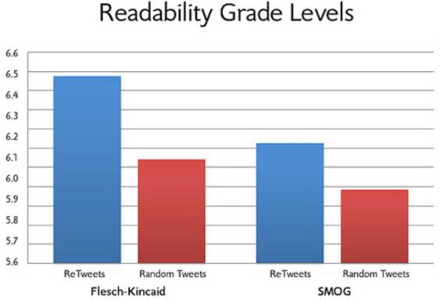Plus: What’s the best hashtag length, word length and reading grade level for Twitter?
Sure, Twitter has a 280-character limit. But just because Twitter has doubled its 140-character limit doesn’t mean you should use all of them.

So what’s the ideal length of a tweet? A hashtag? How else can you make your tweets more readable and engaging? Let’s look at the research:
1. Write long tweets.
So you’ve written your blog post, and now you want to get the word out on Twitter. How long should your tweet be? 190 characters? Longer than 140 characters?
Turns out longer tweets get most engagements, according to an analysis by Sotrender and the Chicago Tribune
Why?
Retweets, likes, replies, impressions, link clicks, and profile clicks increase with length. You’ll get more engagements if your tweets are 240-259 words, according to an analysis of tweets by the Chicago Tribune.
2. Use hashtags … but not too many.
What about hashtags? We’ve all seen people tweet 140 characters to 280 on hashtags. So how long is too long?
Let’s look at the research:

- Use hashtags, according to research by Buffer Media. Tweets with hashtags get twice the engagement of tweets without them.
- But don’t overuse them. Tweets with one or two hashtags get 21% higher engagement than those without, Buffer found. But engagement drops when you add more.
- Make them short. Keep them to 6 characters or less, recommends Vanessa Doctor from Hashtags.org.
3. Make tweets easy to read.
Retweets on average scored 6.47 on the Flesh-Kincaid Index, according to Dan Zarrella, HubSpot’s viral marketing scientist. Random tweets scored even lower: 6.04 years on the Flesch-Kincaid Index.

Zarrella should know. He spent nine months analyzing 5 million tweets and 40 million retweets to find what makes some messages travel the world while others just stay home on the couch.
“Easy-to-read posts are more liked, commented on, and shared on social media,” according to a 2018 study published in the Journal of Consumer Psychology.
To make sure your tweets get retweeted, aim for 6th to 7th grade level on the Flesch test. Don’t like your score? Reduce your grade level by reducing sentence length and word length.
4. Write simple sentences. Period.
Zarrella also found that retweets are heavier on nouns, proper nouns and third-person verbs than tweets in general. That suggests that newsy, headline-style tweets — subject, verb, object — are more likely to go viral.

Want to see your tweet go viral? Write mostly simple sentences.
And don’t drop the punctuation. Some 98% of retweets contain some form of punctuation, compared with 86% of normal tweets, Zarrella found.

So don’t forget the colons, periods, commas and hyphens. But do forget semicolons — “the only unretweetable punctuation mark,” according to Zarrella.
5. Keep words short.
Retweets actually have more syllables than ordinary tweets — 1.62 syllables per word vs. 1.58, Zarrella found. Outside the Twitterverse, experts suggest aiming for two-syllable words, so both measures are still, understandably, simple.
Want your tweets to spread? Write mostly in one- and two-syllable words.
And skip the slang. Lazy language like lol, gonna and hey are among the 20 least retweetable words in the English language, Zarrella found. So cut the vernacular.
___
Sources: Kurt Gessler, “Twitter length study: Do longer tweets drive more engagement and referral traffic?,” Medium, Jan. 8, 2020
Ethan Pancer, et. al., “How Readability Shapes Social Media Engagement,” Journal of Consumer Psychology 29(2), October 2018
Dan Macsai, “Report: Nine Scientifically Proven Ways to Get Retweeted on Twitter,” Fast Company, Sept. 25, 2009
Dan Zarrella, “The Science of ReTweets: Viral Content Sharing on Twitter” (PDF), 2009

Leave a Reply